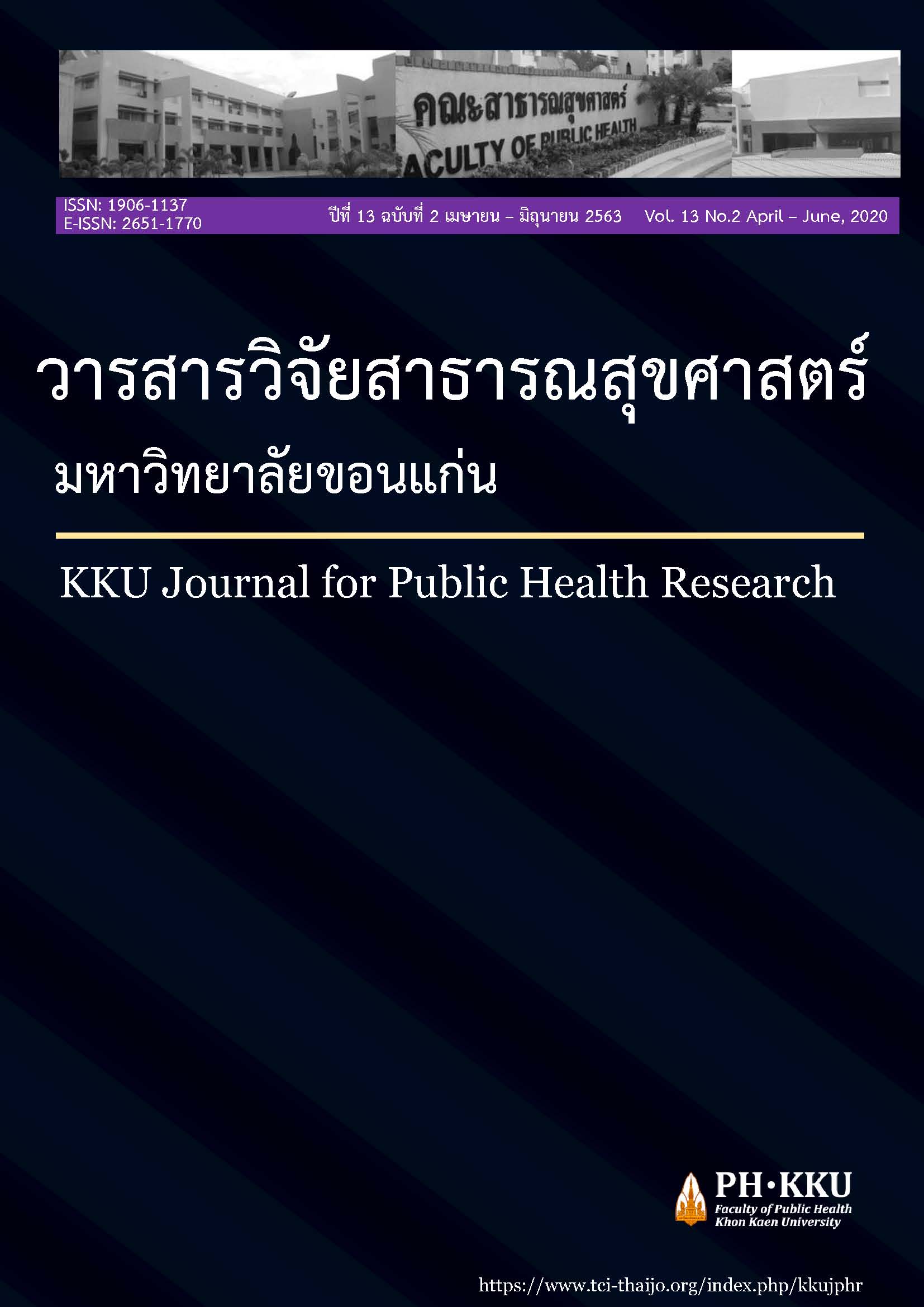Risk Assessment of Chlorination Disinfection Byproducts from Ingestion of Municipal Tap Water Supply in Khon Kaen, Thailand
คำสำคัญ:
trihalomethanes (THMs), haloacetic acids (HAAs), dissolved organic carbon (DOC), free chlorine, rainy seasonบทคัดย่อ
บทนำ งานวิจัยนี้มีวัตถุประสงค์เพื่อประเมินความเสี่ยงต่อสุขภาพจากสารที่เกิดจากการฆ่าเชื้อโรคในน้ำประปา (Disinfection by-products, DBPs) ด้วยคลอรีนเนื่องจากมีรายงานถึงอันตรายต่อสุขภาพมาอย่างต่อเนื่อง วิธีวิจัย ทำโดยการเก็บน้ำตัวอย่าง 5 จุด ตามระยะทางส่งน้ำในช่วงฤดูฝน(กลางกันยายน-ตุลาคม 2557) และหลังฤดูฝน (พฤศจิกายน-ธันวาคม 2557) วิเคราะห์ THMs (Trihalomethanes) โดยใช้วิธี Purge and Trap และ GC-ECD วิเคราะห์ HAAs (Haloacetic acids) โดยใช้ LCMSMS ผลการวิจัย พบว่ามี THMs เกิดขึ้นจากการฆ่าเชื้อโรคด้วยคลอรีนโดยมีความเข้มข้นสูงที่สุดในจุดเก็บตัวอย่างจุดสุดท้าย ช่วงหลังฤดูฝนพบ THMs สูงกว่าช่วงฤดูฝน เมื่อเปรียบเทียบระดับ THMs จากการคำนวณ best case scenario (น้ำที่เพิ่งผ่านกระบวนการผลิต) กับค่ากำหนดใน US.EPA พบว่าได้ค่าความปลอดภัย (safety factors) <1 คือ chloroform=0.95, total THMs=0.72 การประเมินความเสี่ยงพบว่าความเป็นพิษแบบมีระดับกั้น (threshold toxicity) ของ THMs ในน้ำยังอยู่ในช่วงที่ยอมรับได้ แต่ความเสี่ยงต่อการเกิดมะเร็งตลอดช่วงชีวิต (lifetime excess cancer risk) หรือ ความเป็นพิษแบบไม่มีระดับกั้น (non-threshold toxicity) จากการกินสูงเกินกว่า 243 เท่าของค่าที่ยอมรับได้ในกรณี best case และสูงกว่า 363 เท่าของค่าที่ยอมรับได้ในกรณี worst case แต่กรณีความเสี่ยงจาก HAAs ในน้ำยังอยู่ในช่วงที่ยอมรับได้ สรุป ความเสี่ยงต่อการเกิดมะเร็งจากสารประกอบ THMs เป็นเรื่องน่ากังวลสำหรับผู้บริโภคน้ำประปาในเขตเทศบาลเมือง จ.ขอนแก่น และประชากรที่อยู่อาศัยในจุดสุดท้ายที่เก็บตัวอย่างน้ำจะมีความเสี่ยงสูงขึ้นเมื่อเปรียบเทียบกับผู้ที่อยู่อาศัยใกล้สถานีผลิตน้ำประปาโดยเฉพาะอย่างยิ่งในฤดูแล้ง
เอกสารอ้างอิง
Agency for Toxic Substances and Disease Registry [ATSDR]. (2005). Public health assessment guidance manual (2005 update): Appendix G, calculating exposure doses. Retrieved June 30, 2016, from https://www.atsdr.cdc.gov/hac/phamanual/appg.html
Allonier, A. S., Khalanski, M., Bermond, A., & Camel, V. (2000). Determination of trihalomethanes in chlorinated sea water samples using a purge-and-trap system coupled to gas chromatography. Talanta, 51(3), 467–477.
American Public Health Association [APHAล. (2012). Standard methods for the examination of water and wastewater (22nd ed.). Washington, DC: American Public Health Association, American Water Works Association and Water Environment Federation.
Basu, M., Gupta, S. K., Singh, G., & Mukhopadhyay, U. (2011). Multi-route risk assessment from trihalomethanes in drinking water supplies. Environmental Monitoring and Assessment, 178, 121-134.
Chatsantiprapa, K., Kongngern, P., & Thappasarasart, S. (in press). Risk assessment of chlorination disinfection byproducts in tap water after boiling and in swimming pool water.
DEQ. (2015). Remediation and Redevelopment Division Michigan Department of Environmental Quality: Drinking water intake rate, attachment H part 201 generic exposure assumption values update, technical support document. Retrieved November 27, 2014, from https://www.michigan.gov/documents/ deq/deq-rrd-chem-MDEQDrinkingWaterIngestionRateTSDSRC_527402_7.pdf
Faust, S. D., & Aly, O. M. (1998). Chemistry of water treatment. 2nd ed. Chelsea: Ann Arbor Press.
Gough, R., Holliman, P. J., Willis, N., & Freeman, C. (2014). Dissolved organic carbon and trihalomethane precursor removal at a UK upland water treatment works. Science of The Total Environment, 468–469, 228–239.
Health Canada. (2008). Guidelines for Canadian drinking water quality: Guidelines technical document-haloacetic acids. Retrieved November 27, 2014, from http://www.hc-sc.gc.ca/ewh-semt/pubs/water-eau/haloaceti/index-eng.php
Hogan, M. D. (1979). Association between chloroform level in finished drinking water supplies and various, site-specific cancer mortality rates. Journal of Environmental Pathology and Toxicology, 2(3), 873-887.
Integrated Risk Information System [IRIS]. (2009). Integrated Risk Information System of United States. Washington DC: Environmental Protection Agency.
International Agency for Research on cancer [IARC]. (2016). IARC monographs on the evaluation of carcinogenic risks to humans. Retrieved June 15, 2016, from http://monographs.iarc.fr/ENG/Classification/latest_classif.php
Kim, B., Choi, K., Kim, C., Lee, U. H., & Kim, Y. H. (2000). Effects of the summer monsoon on the distribution and loading of organic carbon in a deep reservoir, Lake Soyang, Korea. Water Research, 34(14), 3495–3504.
Minera, R. A., & Amy, G. L. (1996). Disinfection by-products in water treatment: The chemistry of their formation and control. Boca Raton: Lewis Publisher.
N. H. Department of Environmental Services. (2011). New Hampshire sample collection & preservation manual for drinking water. Retrieved February 17, 2014, from https://www.des.nh.gov/organization/commissioner/ pip/publications/co/documents/r-co-01-5.pdf
Pentamwa, P., Sukton, B., Wongklom, T., & Pentamwa, S. (2013). Cancer risk assessment from trihalomethanes in community water supply at Northeastern Thailand. International Journal of Environmental Science and Development, 4(5), 538-544
RAIS. (2009). Risk assessment information system. Retrieved September 17, 2018, from https://rais.ornl.gov/ tools/rais_chemical_prg_guide.html
RAIS. (n.d). Risk assessment information system: Chemical data profiles. Retrieved September 17, 2018, from https://rais.ornl.gov/tools/profile.php
Rodriguez, M. J., Serodes, J., & Levallois, P. (2004). Behavior of trihalomethanes and haloacetic acids in a drinking water distribution system. Water Research, 38, 4367-4382.
Siddigue, A., Saied, S., Mumtaz, M., Hussain, M. M., & Khwaja, H. A. (2015). Multipathways human health risk assessment of trihalomethane exposure through drinking water. Ecotoxicology and Environmental Safety, 116, 129-136.
Siudek, P., Frankowski, M., & Siepak, J. (2015). Seasonal variations of dissolved organic carbon in precipitation over urban and forest sites in central Poland. Environmental Science and Pollution Research International, 22, 11087–11096
SizeThailand. (2007-2008). Survey of morphology whole country Thailand.(2550-2551). Retrieved Jul 11, 2016, from http://www.sizethailand.org
US EPA. (2009). Final report: Health risk of the trihalomethanes found in drinking water carcinogenic activity and interactions. Retrieved June 14, 2016, from https://cfpub.epa.gov/ncer_abstracts/index.cfm/fuseaction/ display.highlight/abstract/22/report/F
US.EPA. (n.d.). Integrated risk information system: US environmental protection agency. Retrieved Jul 21, 2016, from https://www.epa.gov/iris
World Health Organization. (2004). Trihalomethanes in drinking-water. Background document for development of WHO guidelines for drinking water quality. Retrieved June 14, 2016, from http://www.who.int/water_ sanitation_health/dwq/chemicals/en/trihalomethanes.pdf
Yee, L. F., Abdullah, M. P., Ata, S., & Ishak, B. (2006). Dissolved organic matter and its impact on the chlorine demand of reated water. The Malaysian Journal of Analytical Sciences, 10(2), 243-250.
Zaffiro, A.D., Zimmerman, M., Pepich, B. V., Slingsby, R. W., Jack, R. F., Pohl, C.A,, et al. (2009). Determination of haloacetic acids, Bromate, and dalapon in drinking water by ion chromatography electrospray ioinization tandem mass spectrometry (IC-ESI-MS/MS). Ohio Center Office of Ground Water and Drinkingwater, U.S. Envirometal protection Agency.



